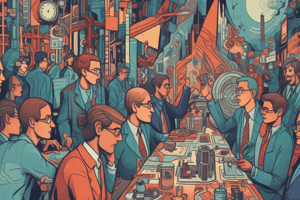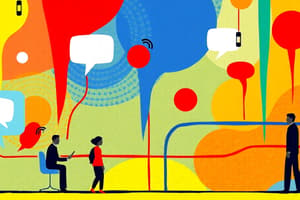Podcast
Questions and Answers
What is a significant drawback of informal communication?
What is a significant drawback of informal communication?
- It usually leads to official announcements.
- It is always trustworthy.
- It requires formal channels.
- It spreads rapidly and can get distorted. (correct)
Which type of grapevine network allows individuals to communicate exclusively with whom they trust?
Which type of grapevine network allows individuals to communicate exclusively with whom they trust?
- Single strand network
- Probability network
- Cluster network (correct)
- Gossip network
Which of the following is NOT categorized as a barrier to communication?
Which of the following is NOT categorized as a barrier to communication?
- Cultural barriers
- Semantic barriers
- Technological barriers (correct)
- Psychological barriers
How can psychological barriers affect communication?
How can psychological barriers affect communication?
What is the primary cause of semantic barriers in communication?
What is the primary cause of semantic barriers in communication?
Which grapevine communication network is characterized by non-selective communication?
Which grapevine communication network is characterized by non-selective communication?
What should managers do to overcome communication barriers?
What should managers do to overcome communication barriers?
Which scenario likely reflects a semantic barrier in communication?
Which scenario likely reflects a semantic barrier in communication?
What is a key characteristic of the contingency approach to organizational design?
What is a key characteristic of the contingency approach to organizational design?
Which factor is NOT mentioned as influencing organizational design in the contingency approach?
Which factor is NOT mentioned as influencing organizational design in the contingency approach?
According to F.W. Taylor, what is NOT a principle of scientific management?
According to F.W. Taylor, what is NOT a principle of scientific management?
What is the main focus of the principle 'Science, not the Rule of Thumb' in scientific management?
What is the main focus of the principle 'Science, not the Rule of Thumb' in scientific management?
Which of the following best describes F.W. Taylor's contribution to management?
Which of the following best describes F.W. Taylor's contribution to management?
What does the contingency approach suggest regarding organizational structure?
What does the contingency approach suggest regarding organizational structure?
Which aspect of management did F.W. Taylor focus on more than others?
Which aspect of management did F.W. Taylor focus on more than others?
What outcome does Taylor believe can result from scientifically analyzing work tasks?
What outcome does Taylor believe can result from scientifically analyzing work tasks?
What is essential for effective decision-making according to the content?
What is essential for effective decision-making according to the content?
Why is sufficient time important in the decision-making process?
Why is sufficient time important in the decision-making process?
What must be considered before making a decision according to the content?
What must be considered before making a decision according to the content?
How should a decision-maker participate in the decision-making process?
How should a decision-maker participate in the decision-making process?
What can rigid mental setups lead to in decision-making?
What can rigid mental setups lead to in decision-making?
What is a consequence of ignoring the chain of actions during decision-making?
What is a consequence of ignoring the chain of actions during decision-making?
What does Vroom's Expectancy Theory suggest about individual behavior?
What does Vroom's Expectancy Theory suggest about individual behavior?
What is the primary objective of a decision within an organization?
What is the primary objective of a decision within an organization?
Which of the following is NOT a form of financial incentive mentioned?
Which of the following is NOT a form of financial incentive mentioned?
What is one of the types of decision-making processes mentioned?
What is one of the types of decision-making processes mentioned?
How are employees rewarded under the productivity linked wage incentive scheme?
How are employees rewarded under the productivity linked wage incentive scheme?
What is a common component of salary in the context of financial incentives?
What is a common component of salary in the context of financial incentives?
What is the primary essence of management according to most writers on the subject?
What is the primary essence of management according to most writers on the subject?
In which scenario do employees receive a bonus?
In which scenario do employees receive a bonus?
Which of the following statements best reflects the definition of decision-making?
Which of the following statements best reflects the definition of decision-making?
Profit-sharing as a financial incentive primarily motivates employees to:
Profit-sharing as a financial incentive primarily motivates employees to:
Which of the following is an example of a retirement benefit?
Which of the following is an example of a retirement benefit?
According to George Terry, what does decision-making involve?
According to George Terry, what does decision-making involve?
Which aspect does Vroom's Expectancy Theory primarily focus on regarding motivation?
Which aspect does Vroom's Expectancy Theory primarily focus on regarding motivation?
What is a key implication when managers make decisions?
What is a key implication when managers make decisions?
What does effective decision-making require according to the principles outlined?
What does effective decision-making require according to the principles outlined?
Which aspect distinguishes decision-making from mere choice?
Which aspect distinguishes decision-making from mere choice?
What role do correct decisions play in an organization?
What role do correct decisions play in an organization?
Which of the following statements best summarizes P.F. Drucker’s view on management?
Which of the following statements best summarizes P.F. Drucker’s view on management?
What is the primary purpose of stock options in a company?
What is the primary purpose of stock options in a company?
Which of the following best describes perquisites?
Which of the following best describes perquisites?
How do commissions typically function as an incentive?
How do commissions typically function as an incentive?
What role does status play in an organization?
What role does status play in an organization?
Which of the following is NOT a typical non-financial incentive?
Which of the following is NOT a typical non-financial incentive?
Why might financial incentives also impact non-financial motivations?
Why might financial incentives also impact non-financial motivations?
What is a key characteristic of stock options?
What is a key characteristic of stock options?
How do non-financial incentives contribute to employee motivation?
How do non-financial incentives contribute to employee motivation?
Flashcards
What is informal communication?
What is informal communication?
Informal communication spreads quickly, often gets distorted and it's hard to trace the source.
How can informal communication impact organizations?
How can informal communication impact organizations?
Rumors are false information spread through informal channels causing misinformation and potential harm to individuals and organizations.
Describe the single strand grapevine network.
Describe the single strand grapevine network.
A communication network where information is shared in a sequential chain, like a single line.
Define the gossip network in grapevine communication.
Define the gossip network in grapevine communication.
Signup and view all the flashcards
What is the probability network in grapevine communication?
What is the probability network in grapevine communication?
Signup and view all the flashcards
Explain the cluster network in grapevine communication.
Explain the cluster network in grapevine communication.
Signup and view all the flashcards
What are communication barriers?
What are communication barriers?
Signup and view all the flashcards
How do semantic barriers affect communication?
How do semantic barriers affect communication?
Signup and view all the flashcards
Decision-making
Decision-making
Signup and view all the flashcards
Decision-making: Importance in Management
Decision-making: Importance in Management
Signup and view all the flashcards
Decision
Decision
Signup and view all the flashcards
Alternatives in Decision-making
Alternatives in Decision-making
Signup and view all the flashcards
Purpose in Decision-making
Purpose in Decision-making
Signup and view all the flashcards
Environmental Context in Decision-making
Environmental Context in Decision-making
Signup and view all the flashcards
Tackling Problems and Opportunities with Decisions
Tackling Problems and Opportunities with Decisions
Signup and view all the flashcards
Decision-making in Management Functions
Decision-making in Management Functions
Signup and view all the flashcards
Contingency Approach to Organization Design
Contingency Approach to Organization Design
Signup and view all the flashcards
Factors Influencing Organizational Design
Factors Influencing Organizational Design
Signup and view all the flashcards
Scientific Management
Scientific Management
Signup and view all the flashcards
Who is Frederick Winslow Taylor?
Who is Frederick Winslow Taylor?
Signup and view all the flashcards
Science, Not Rule of Thumb
Science, Not Rule of Thumb
Signup and view all the flashcards
Division of Labor
Division of Labor
Signup and view all the flashcards
Selection and Training
Selection and Training
Signup and view all the flashcards
Cooperation, Not Individualism
Cooperation, Not Individualism
Signup and view all the flashcards
Sufficient Time for Decision-Making
Sufficient Time for Decision-Making
Signup and view all the flashcards
Decision Impact Analysis
Decision Impact Analysis
Signup and view all the flashcards
Decision-Maker Participation
Decision-Maker Participation
Signup and view all the flashcards
Flexibility in Decision-Making
Flexibility in Decision-Making
Signup and view all the flashcards
Chain of Actions in Decision-Making
Chain of Actions in Decision-Making
Signup and view all the flashcards
Types of Decision-Making
Types of Decision-Making
Signup and view all the flashcards
Organizational Decision-Making
Organizational Decision-Making
Signup and view all the flashcards
Importance of Decision-Making
Importance of Decision-Making
Signup and view all the flashcards
Psychological Relief
Psychological Relief
Signup and view all the flashcards
Vroom's Expectancy Theory
Vroom's Expectancy Theory
Signup and view all the flashcards
Financial Incentives
Financial Incentives
Signup and view all the flashcards
Salary
Salary
Signup and view all the flashcards
Bonus
Bonus
Signup and view all the flashcards
Productivity-Linked Wage Incentives
Productivity-Linked Wage Incentives
Signup and view all the flashcards
Profit-Sharing
Profit-Sharing
Signup and view all the flashcards
Retirement Benefits
Retirement Benefits
Signup and view all the flashcards
Stock Options
Stock Options
Signup and view all the flashcards
Commission
Commission
Signup and view all the flashcards
Perquisites
Perquisites
Signup and view all the flashcards
Non-financial Incentives
Non-financial Incentives
Signup and view all the flashcards
Status
Status
Signup and view all the flashcards
Sense of Belonging
Sense of Belonging
Signup and view all the flashcards
Growth Opportunities
Growth Opportunities
Signup and view all the flashcards
Recognition and Appreciation
Recognition and Appreciation
Signup and view all the flashcards
Study Notes
Communication- meaning
- Communication refers to the transmission of information or a message from a sender to a receiver, overcoming any barriers that affect the speed of this transmission.
- The process is cyclical, beginning with the sender and concluding with feedback from the receiver.
- Communication flows upward, downward, and laterally throughout an organization.
- It's a continuous and dynamic interaction, influenced by several variables.
- Communication consists of steps that are essential to effective communication.
The Different Elements in The Process of Communication
- Sender: The initiator of the communication process, conveying a message, which can be a thought, idea, a symbol, picture, report, or an order.
- Message: The information that the sender intends to convey to the receiver.
- Encoding: The process of translating the message into a suitable medium (verbal or nonverbal, depending on the context).
- Channel: The method by which the message is transmitted (e.g., oral, written, memo, computer, telephone, app, or television).
- Receiver: The recipient of the message, who is expected to comprehend the message's true intent.
- Decoding: The recipient's interpretation and understanding of the message.
- Feedback: The receiver's response to the sender, completing the communication cycle. It ensures the message was effectively encoded, sent, decoded, and understood. Crucial for effective communication.
Studying That Suits You
Use AI to generate personalized quizzes and flashcards to suit your learning preferences.





